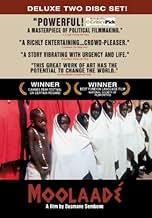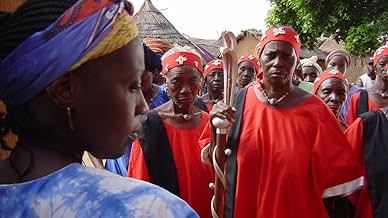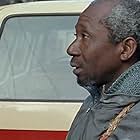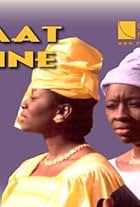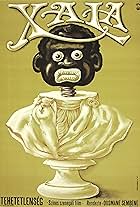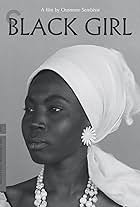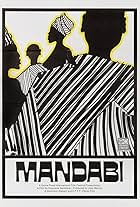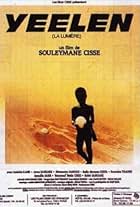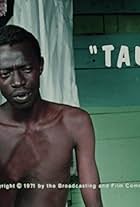IMDb RATING
7.6/10
4.2K
YOUR RATING
When a woman shelters a group of girls from suffering female genital mutilation, she starts a conflict that tears her village apart.When a woman shelters a group of girls from suffering female genital mutilation, she starts a conflict that tears her village apart.When a woman shelters a group of girls from suffering female genital mutilation, she starts a conflict that tears her village apart.
- Awards
- 6 wins & 10 nominations
Photos
Rasmané Ouédraogo
- Ciré Bathily
- (as Rasmane Ouedraogo)
Théophile Sowié
- Ibrahima
- (as Moussa Théophile Sowié)
Sory Ibrahima Koïta
- Kémo Ansumana
- (as Ibrahima Sory Koita)
- Director
- Writer
- All cast & crew
- Production, box office & more at IMDbPro
Storyline
Did you know
- TriviaThe meaning of the word Moolaadé is magical protection.
- GoofsMercenaire's shirt is drenched with sweat when he takes a drink before setting up shop, but is dry when customers begin to arrive.
- ConnectionsFeatured in Siskel & Ebert: The Best Films of 2004 (2005)
Featured review
Six girls from a rural village in Burkina Faso escape from a 'purification' ceremony, the female circumcision ritual that is still practiced in 34 of the 58 nations in the African Union. Two head for the city. The other four know of a woman in the village who, some years earlier, had prevented her own daughter from being cut. They run to her home, where she is the second of three wives of a man whose brother is a figure in the town's power structure. To protect them, she pronounces a moolaadé, an unbreakable spell of sanctuary that can only be dissolved by her word, and which is marked simply by stretching some colored strands of yarn across the enclave's doorway.
This is the narrative set up of Ousmane Sembene's latest film, Moolaadé, which had its Philadelphia debut in a packed (literally sitting in the aisles) auditorium at the International House cinema last week. How will the townspeople react to this open rebellion against female genital mutilation? How will the men who govern the town respond? What about the women who actually perform these ceremonies, presented in the film virtually as a coven of witches dressed entirely in red? And, especially, what about the town's other women? Will Collé Gallo Ardo Sy recant the mooladé? Will the village ever again be the same?
All these questions are literally put on the table in the first ten minutes of this remarkable motion picture, beautifully filmed & amazingly acted, full of agitprop theatrics & yet as tightly & deeply scripted I mean this literally as any Shakespearean tragedy. That's a combination that is uniquely the signature of Africa's master film maker, Ousmane Sembene.
Had Sembene not been drafted into the French army in his native Senegal at the age of 15 in 1939, he might not have joined the Free French forces fighting the Nazis in '42 & thus might not have ended up after the war in France, working on the docks in Marseilles, where he wrote and published his first novel, Le Docker noir in 1956. It was not usual in the 1950s that a man of his class background in Senegal not a member of any tribal elite even learned to read, let alone became a critically & financially successful intellectual on a world scale. Which must be why Sembene made a conscious decision to study film at the All Russia State Institute for Cinematography founded by Eisenstein & at Gorki Studios in Moscow. In 1966, three years after returning to Senegal, the then-43-year-old Sembene released La Noire de . . ., the first feature-length motion picture produced in Sub-Saharan Africa. His films, which can stand up alongside the best of Bergman, Kurosawa or Godard, are intended for audiences who will see them sitting on dirt floors in African villages.
Feminist themes are common in Sembene's work. Ceddo, my favorite of the three earlier pictures of Sembene's that I've seen, looks at Islamic imperialism in Sub-Saharan Africa precisely in terms of what it meant for the role of women in the tribes. Colonialism, contemporary issues of globalization, modernity & identity are all heightened when viewed through the lens of gender relations. Addressing one must mean addressing all & nobody is in a better position to do so than someone whose identity is both defined & constrained by her gender. On a continent where the ratio of resources to human beings would render an economic determinist suicidal, Sembene has come up with a particularly radical prescription the path through globalization has to proceed through feminism first.
'The West is never my reference,' Sembene says in the Q&A period that follows the picture. He's explaining why it's not a problem that his work tends to be put into a third-world ghetto at European film festivals, even though it plays to packed houses, enthusiastic audiences & consistently wins prizes. Moolaadé, for example, won the Un Certain Regard award this year at Cannes & was relegated to the Planet Africa series at Turin.
Yet, in fact, Moolaadé is very much about the confrontation of rural Africa with the forces of globalization. The girls who flee their mutilation do so because they've seen the consequences dead sisters, maimed women up close & personal. The city urbanization is the refuge that two seek (and when they don't get there, the consequences are grave). The men in the village respond first by banning radios one sees here an economy that built around bread and the access to batteries which are piled outside of the local mosque (where they are left on to play music & some news throughout the entire film up to their climactic scene). When tensions & actions escalate & the men in the village coerce Collé's husband into whipping her in public, the person who steps in to stop the violence is the itinerant shopkeeper, Mercenaire, expelled from the military & living by cheating everybody with a smile in return for his shiny western goods batteries most of all who steps in to protect her. And when, finally, the women of the entire village, save for the mutilating witches, revolt against the men, it is the French-schooled son of the chief who lets it be known that he not only is willing to marry a woman who is bilakoro, uncircumcised, but will go beyond the ban against radios, even to the point of having television. What ultimately rescues the women is not just courage & solidarity the victory comes at a heavy cost but modernity itself. It is precisely the inability of the village to seal itself off from the influences of history, whether in the form of TV, radio, condoms or AIDS posters, that the women's victory will not be overturned.
This is the narrative set up of Ousmane Sembene's latest film, Moolaadé, which had its Philadelphia debut in a packed (literally sitting in the aisles) auditorium at the International House cinema last week. How will the townspeople react to this open rebellion against female genital mutilation? How will the men who govern the town respond? What about the women who actually perform these ceremonies, presented in the film virtually as a coven of witches dressed entirely in red? And, especially, what about the town's other women? Will Collé Gallo Ardo Sy recant the mooladé? Will the village ever again be the same?
All these questions are literally put on the table in the first ten minutes of this remarkable motion picture, beautifully filmed & amazingly acted, full of agitprop theatrics & yet as tightly & deeply scripted I mean this literally as any Shakespearean tragedy. That's a combination that is uniquely the signature of Africa's master film maker, Ousmane Sembene.
Had Sembene not been drafted into the French army in his native Senegal at the age of 15 in 1939, he might not have joined the Free French forces fighting the Nazis in '42 & thus might not have ended up after the war in France, working on the docks in Marseilles, where he wrote and published his first novel, Le Docker noir in 1956. It was not usual in the 1950s that a man of his class background in Senegal not a member of any tribal elite even learned to read, let alone became a critically & financially successful intellectual on a world scale. Which must be why Sembene made a conscious decision to study film at the All Russia State Institute for Cinematography founded by Eisenstein & at Gorki Studios in Moscow. In 1966, three years after returning to Senegal, the then-43-year-old Sembene released La Noire de . . ., the first feature-length motion picture produced in Sub-Saharan Africa. His films, which can stand up alongside the best of Bergman, Kurosawa or Godard, are intended for audiences who will see them sitting on dirt floors in African villages.
Feminist themes are common in Sembene's work. Ceddo, my favorite of the three earlier pictures of Sembene's that I've seen, looks at Islamic imperialism in Sub-Saharan Africa precisely in terms of what it meant for the role of women in the tribes. Colonialism, contemporary issues of globalization, modernity & identity are all heightened when viewed through the lens of gender relations. Addressing one must mean addressing all & nobody is in a better position to do so than someone whose identity is both defined & constrained by her gender. On a continent where the ratio of resources to human beings would render an economic determinist suicidal, Sembene has come up with a particularly radical prescription the path through globalization has to proceed through feminism first.
'The West is never my reference,' Sembene says in the Q&A period that follows the picture. He's explaining why it's not a problem that his work tends to be put into a third-world ghetto at European film festivals, even though it plays to packed houses, enthusiastic audiences & consistently wins prizes. Moolaadé, for example, won the Un Certain Regard award this year at Cannes & was relegated to the Planet Africa series at Turin.
Yet, in fact, Moolaadé is very much about the confrontation of rural Africa with the forces of globalization. The girls who flee their mutilation do so because they've seen the consequences dead sisters, maimed women up close & personal. The city urbanization is the refuge that two seek (and when they don't get there, the consequences are grave). The men in the village respond first by banning radios one sees here an economy that built around bread and the access to batteries which are piled outside of the local mosque (where they are left on to play music & some news throughout the entire film up to their climactic scene). When tensions & actions escalate & the men in the village coerce Collé's husband into whipping her in public, the person who steps in to stop the violence is the itinerant shopkeeper, Mercenaire, expelled from the military & living by cheating everybody with a smile in return for his shiny western goods batteries most of all who steps in to protect her. And when, finally, the women of the entire village, save for the mutilating witches, revolt against the men, it is the French-schooled son of the chief who lets it be known that he not only is willing to marry a woman who is bilakoro, uncircumcised, but will go beyond the ban against radios, even to the point of having television. What ultimately rescues the women is not just courage & solidarity the victory comes at a heavy cost but modernity itself. It is precisely the inability of the village to seal itself off from the influences of history, whether in the form of TV, radio, condoms or AIDS posters, that the women's victory will not be overturned.
- How long is Moolaadé?Powered by Alexa
Details
- Release date
- Countries of origin
- Languages
- Also known as
- Moolaade - fristaden
- Filming locations
- Production companies
- See more company credits at IMDbPro
Box office
- Gross US & Canada
- $215,646
- Opening weekend US & Canada
- $11,982
- Oct 17, 2004
- Gross worldwide
- $495,270
- Runtime2 hours 4 minutes
- Color
- Sound mix
- Aspect ratio
- 1.85 : 1
Contribute to this page
Suggest an edit or add missing content


